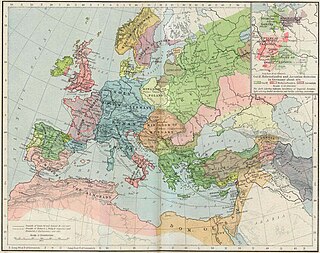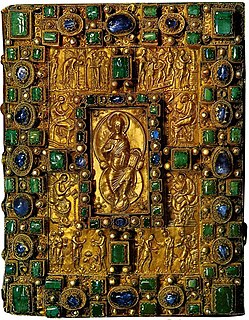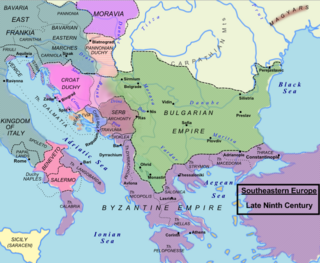
The Latin Empire, also referred to as the Latin Empire of Constantinople, was a feudal Crusader state founded by the leaders of the Fourth Crusade on lands captured from the Byzantine Empire. The Latin Empire was intended to replace the Byzantine Empire as the Western-recognized Roman Empire in the east, with a Catholic emperor enthroned in place of the Eastern Orthodox Roman emperors.

When the Roman Empire divided into east and west in 395, the territories of modern Albania became a part of the Byzantine Empire. At the end of the 12th century, the Principality of Arbanon was formed which lasted until mid 13th century, after its dissolution it was followed with the creation of the Albanian Kingdom after an alliance between the Albanian noblemen and Angevin dynasty. After a war against the Byzantine empire led the kingdom occasionally decrease in size until the Angevins eventually lost their rule in Albania and led the territory ruled by several different Albanian chieftains until the mid 14th century which for a short period of time were conquered by the short-lived empire of Serbia. After its fall in 1355 several chieftains regained their rule and significantly expanded until the arrival of the Ottomans after the Battle of Savra.

The Morea was the name of the Peloponnese peninsula in southern Greece during the Middle Ages and the early modern period. The name was used for the Byzantine province known as the Despotate of the Morea, by the Ottoman Empire for the Morea Eyalet, and later by the Republic of Venice for the short-lived Kingdom of the Morea.

The High Middle Ages, or High Medieval Period, was the period of European history that lasted from AD 1000 to 1300. The High Middle Ages were preceded by the Early Middle Ages and were followed by the Late Middle Ages, which ended around AD 1500.

The Early Middle Ages, sometimes controversially referred to as the Dark Ages, is typically regarded by historians as lasting from the late 5th or early 6th century to the 10th century. They marked the start of the Middle Ages of European history. The alternative term Late Antiquity, for the early part of the period, emphasizes elements of continuity with the Roman Empire, while Early Middle Ages is used to emphasize developments characteristic of the earlier medieval period. As such the concept overlaps with Late Antiquity, following the decline of the Western Roman Empire, and precedes the High Middle Ages.

Byzantine Greece has a history that mainly coincides with that of the Byzantine Empire itself.

The Despotate of Epirus was one of the Greek successor states of the Byzantine Empire established in the aftermath of the Fourth Crusade in 1204 by a branch of the Angelos dynasty. It claimed to be the legitimate successor of the Byzantine Empire, along with the Empire of Nicaea and the Empire of Trebizond, its rulers briefly proclaiming themselves as Emperors in 1227–1242. The term "Despotate of Epirus" is, like "Byzantine Empire" itself, a modern historiographic convention and not a name in use at the time.
Greek Empire can refer to the following:

The Serbian Despotate was a medieval Serbian state in the first half of the 15th century. Although the Battle of Kosovo in 1389 is generally considered the end of medieval Serbia, the Despotate, a successor of the Serbian Empire and Moravian Serbia, lasted for another 60 years, experiencing a cultural and political renaissance before it was conquered by the Ottomans in 1459. Before its conquest the Despotate was a tributary state of the neighbouring Byzantine Empire, Ottoman Empire, and Kingdom of Hungary, all of which considered it to be part of their sphere of influence.

In the medieval history of Europe, Bulgaria's status as the Bulgarian Empire occurred in two distinct periods: between the seventh and eleventh centuries, and again between the twelfth and fourteenth centuries. The two "Bulgarian Empires" are not treated as separate entities, but rather as one state restored after a period of Byzantine rule over its territory.

Despot or despotes was a senior Byzantine court title that was bestowed on the sons or sons-in-law of reigning emperors, and initially denoted the heir-apparent of the Byzantine emperor.

The Frankokratia, also known as Latinokratia and, for the Venetian domains, Venetokratia or Enetokratia, was the period in Greek history after the Fourth Crusade (1204), when a number of primarily French and Italian states were established by the Partitio terrarum imperii Romaniae on the territory of the dissolved Byzantine Empire.
After the weakening of the Byzantine Empire and the Bulgarian Empire in the middle and late 13th century, the northern territory of modern day Albania became part of Serbia. Firstly, as part of Serbian Grand Principality and later as part of Serbian Empire. The southern part was governed by the semi-independent, Serbian-ruled Despotate of Epirus. Between 1272 and 1368, some areas of the modern-day state were also ruled by the Angevins as the Kingdom of Albania. In the late 14th century, Albanian Principalities were created throughout Albania.
Vagenetia or Vagenitia was a medieval region on the coast of Epirus, roughly corresponding to modern Thesprotia. The region likely derived its name from the Slavic tribe of the Baiounitai. It is first attested as a sclavinia under some sort of Byzantine control in the 8th/9th centuries, passed under Bulgarian rule in the late 9th century, and returned to Byzantine rule in the 11th. It passed to the Despotate of Epirus after 1204, where it formed a separate province. Vagenetia came under Albanian rule in the 1360s, until conquered by the Ottoman Empire in 1430.

The Kingdom of Serbia, or the Serbian Kingdom, was a medieval Serbian state that existed from 1217 to 1346 and was ruled by the Nemanjić dynasty. The Grand Principality of Serbia was elevated with the regal coronation of Stefan Nemanjić as king, after the reunification of Serbian lands. In 1219, Serbian Orthodox Church was reorganized as an autocephalous archbishopric, headed by Saint Sava. The kingdom was proclaimed an empire in 1346, but kingship was not abolished as an institution, since the title of a king was used as an official designation for a co-ruler of the emperor.
Kran is a town in central Bulgaria. It is located just south of the Balkan Mountains and is administratively part of Kazanlak Municipality, Stara Zagora Province. Kran was an important castle of the Second Bulgarian Empire in the 13th–14th century. Among the local sights are a conserved ancient Thracian tomb, a much older Thracian sanctuary and the ruins of the medieval fortress.
Dryinopolis or Dryinoupolis is a historical region in southwestern Albania and northwestern Greece in Epirus. The heartland of this region is the valley of the Drino river and Dropull/Dropolis. A Greek-Orthodox bishopric under this name was established at 449 AD as well as a theme (district) of the Byzantine Empire and the Despotate of Epirus. Today the name of Dryinopolis is preserved in the local metropolitan bishopric of the Church of Greece for the Greek part of the region, while the Albanian part is under the religious jurisdiction of the metropolis of Gjirokaster of the Autocephalous Orthodox Church of Albania.
Kolonjë is a municipality in Korçë County, southeastern Albania. It was created in 2015 by the merger of the former municipalities Barmash, Çlirim, Ersekë, Leskovik, Mollas, Novoselë, Qendër Ersekë and Qendër Leskovik. The seat of the municipality is the town Ersekë. The total population is 11,070, in a total area of 865 km2 (334 sq mi). It is an ethnographic region.











